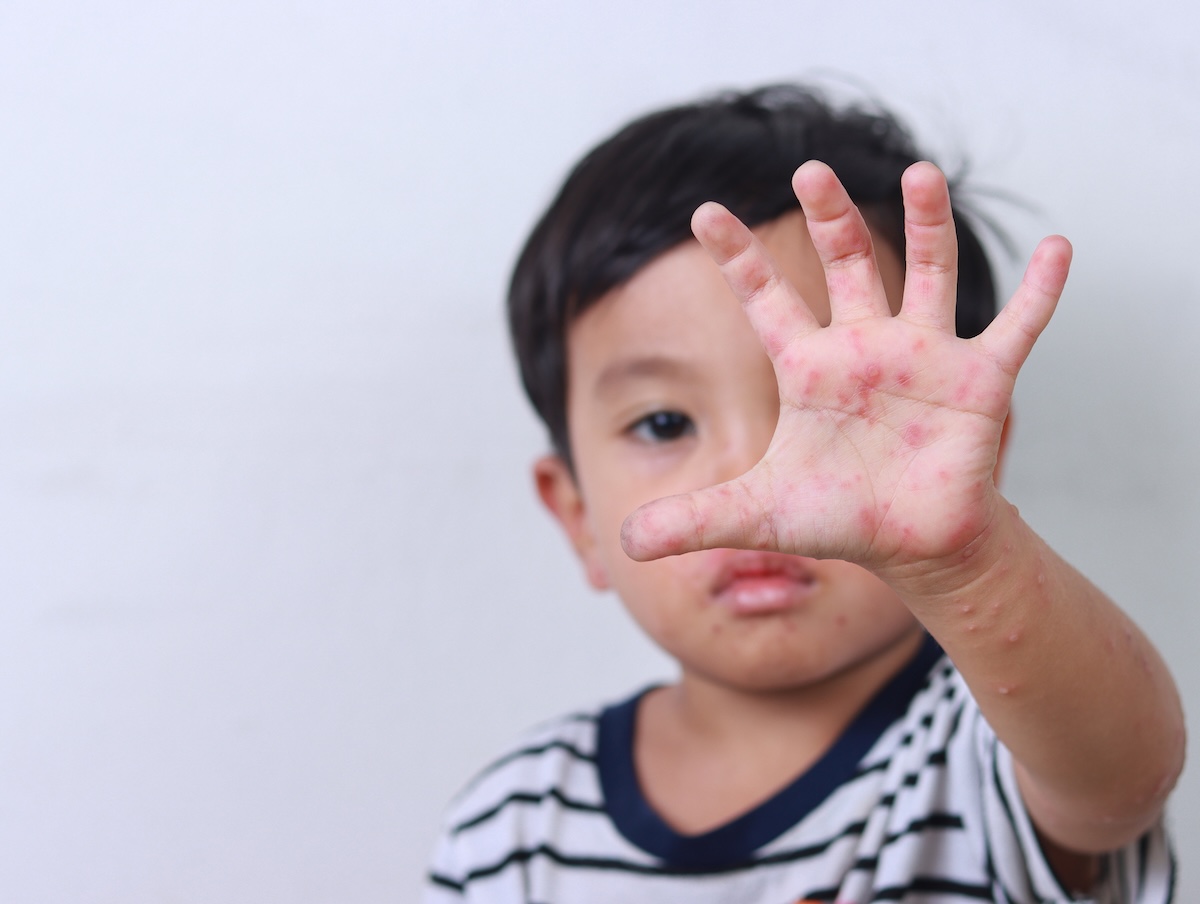Hand, foot, and mouth disease (HFMD) is a common and usually mild illness that mostly affects young children. It gets its name from the small sores or blisters that appear on the hands, feet, and inside the mouth. Although the symptoms can look uncomfortable and sometimes alarming, most children recover within a week without any medical treatment.

This illness is most common in children under five, but older kids and even adults can get it too. It spreads easily, especially in places like daycare centers, playgrounds, and schools. Knowing the signs, how it spreads, and how to care for your child can make the experience less stressful.
What Causes It And The Types Of Viruses Involved
Hand, foot, and mouth disease is caused by viruses from the enterovirus family. The most common one is coxsackievirus A16, but other viruses, such as enterovirus 71, can also cause it. These viruses spread from person to person through saliva, mucus, stool, or contact with surfaces that have the virus on them.
Children can get the virus by touching toys, doorknobs, or changing tables that haven’t been cleaned well. It can also spread through coughing, sneezing, or close contact like hugging. Once infected, it usually takes 3 to 6 days for symptoms to appear.
There aren’t different “types” of HFMD in terms of how it looks or behaves, but the illness can be slightly more severe depending on the virus involved. For example, enterovirus 71 is more likely to lead to complications, although this is still rare.
Most kids only get HFMD once, but it’s possible to catch it again if they’re exposed to a different virus that causes the same condition.
Recognizing The Symptoms of Hand, Foot, and Mouth Disease
The symptoms of hand, foot, and mouth disease usually come on suddenly. A child may first feel tired or cranky and develop a mild fever. The fever often starts before the rash appears. As the illness progresses, small red spots may show up in the mouth, on the hands, and on the soles of the feet. These can turn into tiny blisters that are sometimes painful.
Common symptoms include:
-
Fever (usually low-grade)
-
Sore throat or discomfort while swallowing
-
Painful mouth sores, especially on the tongue, gums, and inside of the cheeks
-
A rash with red spots or blisters on the palms, soles, and sometimes the buttocks or legs
-
Loss of appetite or refusal to eat or drink due to mouth pain
-
General irritability or fussiness in babies and toddlers
The rash is not usually itchy, but the mouth sores can be quite painful, making it hard for children to eat or drink. The illness usually lasts 5 to 7 days, and most children start feeling better within a few days.
It’s important to encourage fluids, especially if your child doesn’t want to eat, to prevent dehydration. Signs of dehydration include a dry mouth, fewer wet diapers, and crying without tears.
How Is Hand, Foot, and Mouth Disease Diagnosed
Doctors usually diagnose hand, foot, and mouth disease based on the child’s symptoms and a physical exam. The pattern of mouth sores and skin rash is often enough to identify the illness without the need for tests.
There is no specific test for HFMD in most cases. However, if the symptoms are severe or the diagnosis is uncertain, your doctor might take a throat swab or stool sample to check for the virus. This is rare and usually only needed during large outbreaks or in children with weaker immune systems.
Because HFMD is caused by a virus, antibiotics won’t help. The illness typically runs its course on its own, and treatment focuses on easing the symptoms.
Treatment And Home Care Tips
There is no cure or antiviral medication for hand, foot, and mouth disease. Most children recover with rest, hydration, and comfort care at home. Since the mouth sores can be painful, keeping your child comfortable is key.
Here are some treatment and care options:
-
Pain relief: Over-the-counter medications like acetaminophen or ibuprofen can help reduce fever and ease discomfort. Never give aspirin to children, as it can cause a serious condition called Reye’s syndrome.
-
Mouth care: Cold drinks, ice pops, or yogurt can soothe sore mouths. Avoid spicy, salty, or acidic foods that might sting. If your child is old enough, rinsing with salt water may help.
-
Skin care: Keep the rash clean and dry. Don’t pop the blisters, as this can lead to infection. Bathing in lukewarm water can help soothe irritated skin.
-
Fluids: Encourage frequent sips of water, clear broth, or oral rehydration solutions to prevent dehydration.
Most children feel better within a week, though some may continue to have a mild rash or peeling skin for a few days after other symptoms go away.
Preventing The Spread Of HFMD
Because HFMD spreads so easily, preventing it can be tough, especially in group settings. Still, good hygiene goes a long way in reducing the risk. Frequent handwashing is the most important step. Teach children to wash their hands after using the bathroom, before eating, and after blowing their nose or coughing.
Other prevention tips include:
-
Disinfecting toys, doorknobs, and surfaces regularly
-
Avoiding close contact like hugging or sharing drinks with infected individuals
-
Keeping sick children home from daycare or school until their fever is gone and their blisters are drying up
Children are most contagious during the first week of illness, but the virus can stay in their stool for several weeks. That’s why handwashing after diaper changes is so important, even after your child seems better.
There is no vaccine for hand, foot, and mouth disease in most countries. However, research continues on ways to reduce the impact of the illness, especially during larger outbreaks.

